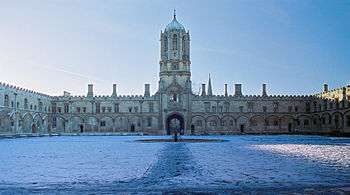Tom Quad

The Great Quadrangle, more popularly known as Tom Quad, is one of the quadrangles of Christ Church, Oxford, England. It is the largest college quad in Oxford, measuring 264 by 261 feet. Although it was begun by Cardinal Wolsey, he was unable to complete it. Wolsey planned that it would actually be a cloister, and the supports required for this can be seen at short intervals around the quadrangle. The quad was finished when John Fell was Dean. The funds for the building of Tom Quad were found from the suppression of three Norbertine abbeys. It is dominated to the west by Tom Tower, designed by Sir Christopher Wren. On the east side is the entrance to Christ Church Cathedral and at the south-east corner is the entrance to the college dining hall. The north contains the homes of the canons of Christ Church, and much of the east side is taken up with the Deanery, in which the Dean of the college lives. On the north-east side, the quad leads, via Kilcannon, to Peckwater Quadrangle and the college library. In the north-west part of the quad is the Junior Common Room ("JCR"). Parts of the quad are still lived in by undergraduates, including the staircase above the Porter's lodge, known as "Bachelors' Row", to the left of the quadrangle when entered via Tom Gate. Bachelors' Row was only inhabited by first year male undergraduates until 2014, when the first female first year undergraduates took up residence there.

In the centre of the quad, there is an ornamental pond with a statue of Mercury. In the past, it was traditional for "hearties" (sporty students) to throw "aesthetes" (more artistic students) into this pond. Currently, entrance to Mercury carries a heavy fine for undergraduates. The pond also contains a large Koi carp apparently worth a large amount of money and donated by the Empress of Japan. The base of the fountain was designed by Sir Edwin Lutyens, the architect who designed much of India's modern capital New Delhi.
Historical examples
Lady Gwendolyn Cecil, in the celebrated biography of her father (the last Victorian Prime Minister Lord Salisbury) recounts how as a student in the 1840s, he rescued his bookish friends from being dunked in the fountains, by infiltrating the hearties and tipping off his friends about the time of the planned raid, and arranging with them a counter-ambush:
"Late that night the intended victim sat in full view of his window, apparently solitary and absorbed in a book. But when his opponents approached the room, flushed with wine and encouraged by the certainty of victory by the unsported oak before them and by the silence that reigned around, they were suddenly startled by a yell from the dark abyss of the staircase above and at the same moment overborne by a tumultuously rushing descent. A minute later, entirely demoralized, they were flying around the quad pursued by a dozen of the most sober, respectable, and peace-loving of the reading men in the college... The next day their opponents were the laughing-stock of the college, and for some time to come a man at Christ Church might read as much and drink as little as he pleased with complete impunity'.'" [1]
Literary references
In a famous scene from Waugh's novel, aesthete Anthony Blanche is accosted by some sportsmen in the manner described above:
"I got into the fountain and, you know, it really was most refreshing, so I sported there a little and struck some attitudes, until they turned about and walked sulkily home, and I heard Boy Mulcaster saying, ‘Anyway, we did put him in Mercury’. You know, Charles, that is just what they'll be saying in thirty years' time. When they're all married to scraggy little women like hens and have cretinous porcine sons like themselves getting drunk at the same club dinner in the same coloured coats, they'll still say when my name is mentioned 'We put him in Mercury one night,' and their barnyard daughters will snigger and think their father was quite a dog in his day, and what a pity he's grown so dull. Oh, la fatigue du Nord!"
Gallery
- View of Tom Quad including Tom Tower

 The entrance to Tom Quad
The entrance to Tom Quad A view looking towards Tom Tower
A view looking towards Tom Tower
See also
| Wikimedia Commons has media related to Christ Church Great Quadrangle. |
- Peckwater Quadrangle
- Blue Boar Quadrangle
- Meadow Building
- Christ Church Library
- Dunster House at Harvard
Coordinates: 51°45′01″N 1°15′21″W / 51.75028°N 1.25583°W
References
- ↑ Lady Gwendolyn Cecil, Life of Robert Marquis of Salisbury, (Hodder & Stoughton, 1921) Vol.1, pp.23-24.